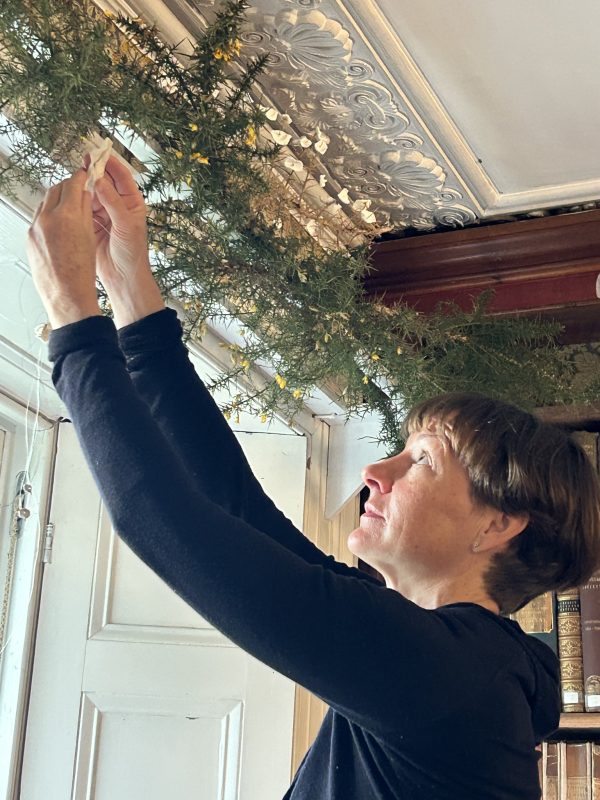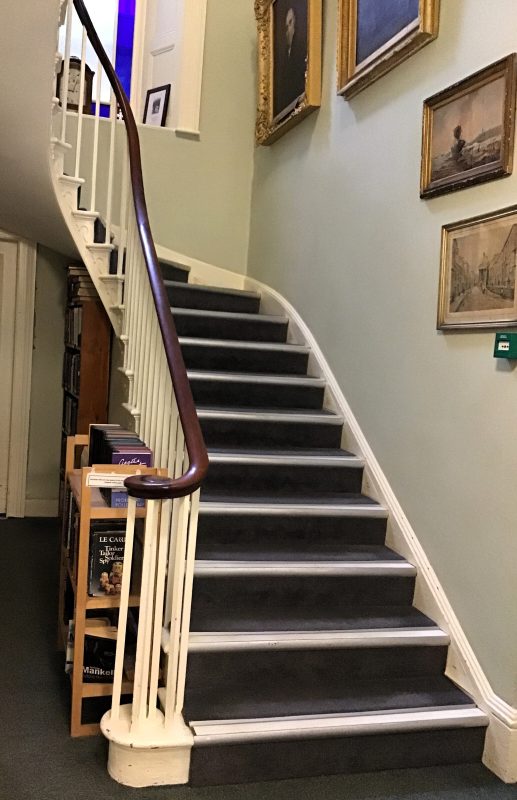Blog
A living library – Lucy Sparrow and Rebecca Harvey’s new work


Artist Rebecca Harvey and poet Lucy Sparrow are joint Artists in Residence at The Morrab Library. Throughout the year, the pair are creating pieces in porcelain and poetry inspired by the library’s rooms, collections and atmosphere.
If you have visited the library recently, you may have paused on the staircase to read Lucy’s latest poem, ‘a living library’ which slinks along the stringer up to the top of the stairs. At each tread, a new line is added to the poem which grows as you climb, repeating itself in a calming refrain up to the landing, from which you can see the room where Lucy first drafted the piece.
Lucy says “‘a living library’ was written in the Poetry Room in The Morrab Library late one sunny afternoon in January 2024. In an armchair surrounded by shelves of books and art works, looking out through an enormous window into the surrounding garden, I felt an intense sense of serenity and connectedness.”
Through their residency Lucy and Rebecca seek to bring to life and shine attention on unexpected places around the building, illuminating quiet corners, treasured reading spots and places of contemplation.
Lucy adds, “The library, crammed with treasures and always welcoming, opens up as a safe yet stimulating space nurturing learning, creativity and reflection.” Through her poem she hopes to “convey the essence of the library, its energy and life revealed through presence and purpose, by the library staff, library members and visitors in this very special place.”


Lucy’s poem is depicted in another form by Rebecca Harvey’s work in the Rees Room, just off the landing. Rebecca works in porcelain and for this new piece she has painted with Cornish clay slip onto the glass panes and has written ‘a living library’ through the clay, letting the light stream through the words.
Sitting at the desk in the Rees Room, surrounded by French fiction, Pelican books and texts in a whole host of languages, you can look out of the window through the poem, or watch the afternoon light play through its letters.
Rebecca describes her process and the inspiration behind the piece below:
“At the top of the stairs I gravitate towards the intimate Rees room as it holds assorted memories of being the first that I spent time in with my young daughter after the first lockdown. The window invites a gaze towards the living life of Penzance, palm trees, close knit houses, sky and drifting interior thoughts.
The pane of glass echoes the page.
The materiality of locally dug kaolin references its granite source and traditional use in paper making.
Textures of brushstrokes soaked in clay, are drawn across the transparent glass and slightly conceal the exterior.
Energy held in the edges of the brushmarks are left, partly inspired by the slightly torn and ruffled edges of a WH Davies book. This book is so beautifully illustrated and belonged to a member of the The Penwith Local History Group who are researching a creative Hilda Quick collection held in the archives.
A sequential gesture of the handwritten words holds the fluid rhythm and pattern which are revealed through the transparency of glass.

Like the poem this understated composition has taken on many permeations before arriving with a somewhat simple interpretation of ‘A Living Library”.”
Lucy and Rebecca’s previous pieces were installed in the Reading Room and you can read about their work in our previous blog post. This summer, Lucy’s poem guides the library visitor gently up from the ground floor and Rebecca’s next porcelain installation can be found in the Rees Room window (upstairs). You can also pick up a copy of Lucy’s poem to take home from the table on the landing.
The installations are open for members and non-members alike to visit during Library opening hours (10-4, Tuesday-Saturday).
Reading List | Katrina Naomi

Katrina Naomi is an award-winning poet, performer and mentor. She has returned to judge our poetry competition, the Patricia Eschen Prize for Poetry, in 2024.
Katrina’s poetry collections have won an Authors’ Foundation Award and Saboteur Award, and she is a recipient of the Keats-Shelley Prize. Katrina’s poetry has appeared on Poems on the Underground, BBC Radio 4’s Front Row and Poetry Please, and in the TLS, The Poetry Review and Modern Poetry in Translation.
Her new collection, Battery Rocks, has won the Arthur Welton Award and is due for publication by Seren in July 2024. In May, Katrina gave a reading at the Library where she read work from previous collections (watch a recording here) and a sneak peek of her new collection.
The reading, and audience questions afterwards, were rich in allusions to other writers and poets. Katrina has kindly shared a ‘‘Reading List’ of books – a mix of poetry, novels and memoir – that were useful to her in the writing of Battery Rocks.


Iris Murdoch – The Sea, The Sea (Fiction)
Monique Roffey – The Mermaid of Black Conch (Fiction)
Anna Selby – Field Notes
Leanne Shapton – Swimming Studies
George Mackay Brown – The Storm
Elizabeth-Jane Burnett – Swims
There are also poems in Battery Rocks in response to the poets Amy Clampitt and Byron, plus one from an unlikely source – a Lillicrap Chilcott advert, which prompted a poem against second homes.


The US poet Sharon Olds was a frequent touchstone in Katrina’s reading and her favourite of Olds’ many collections is Satan Says. If you’d like to read some of Olds poetry, we have Arias (811.6 OLD), The Father (811.54), and The Sign of Saturn (811.6 OLD) available to borrow from the library. She also talked about how she “always find[s] the poet Peter Redgrove a revelation” and recommended his collection In The Hall Saurians. We have The Moon Disposes (821.914), The Cycolean Mistress (C808) and The Nature of Cold (821.914) by Peter Redgrove available to borrow from the Library, and recommend trying the Penzance Public Library for other titles from Katrina’s list that we don’t have in our collection.
You can watch a clip of Katrina reading a selection of poems from previous collections here and borrow her collections from the Library too.


Photo of Katrina Naomi credit: Ian Kingsnorth
Reading List for Guy English’s talk about ‘The Holy Wells of Cornwall’
Every month at The Morrab Library we host talks in the Reading Room for library members and non-members alike. The programme is as eclectic as the library’s collection – from the Holy Wells of Cornwall to the History of the English Miniature Painting – and meander through Literature, Poetry, Art, Geology and a host of other fascinating subjects in between.
Often, the writers, academics, poets and artists we invite to speak at the Library generously let us record their talk so we can share them with a wider audience online. You can browse the selection of recorded talks here.
Some of our brilliant speakers also use the Library’s archive, newspaper and book collections for their own research. In homage to BBC Radio 4’s In Our Time, we are hoping to share a “Reading List” to go with each talk recording, in case you would like to follow up on the talk by borrowing related titles from the Library or delving into our archives.
We’ll be publishing these reading lists on our blog on a monthly basis so please do keep checking back for updated reading lists.
Last month, we shared a reading List for Kensa Broadhurst’s talk “The Cornish Language in West Penwith in the 19th Century” and this month you’ll find Guy English’s Holy Wells of Cornwall reading list below.
‘The Holy Wells of Cornwall’
One of our brilliant volunteers, Guy English, gave a talk in the Reading Room back in February about ‘The Holy Wells of Cornwall’.
He told the story of searching for Cornwall’s Holy Wells, first in chance encounters, then by turns curiously, obsessively, finally doggedly. For five years Guy English and his late wife Catharine scoured the county, following the previous authors, but also checking maps, streams, apparently pointless footpaths, and in the process found more than twenty wells not previously recorded.

Their hope is the book – Holy Wells Cornwall: Odyssey & Memorial – will encourage others to seek these wells. Some are special for beauty, for remoteness, for the spiritual sense that many recognise, or for the stories which have accreted over time. At the very least, there are some good walks, and the discovery of parts of Cornwall not to be missed. But this is also a story of their partnership, and something of a memorial, being one part of the huge legacy of art and poetry left by Guy’s wife of fifty years.
All of the books mentioned in Guy’s Reading List below can be found in the Jenner Room (our Cornish collection) which is located on the ground floor of The Morrab Library. The Dewey Decimal Number for each book can be found next to the author in the list below. Please ask a member of staff if you need help finding the books, or email enquiries@morrablibrary.org.uk if you would like to reserve any of these titles.


Holy Wells of Cornwall by Catharine & Guy English – C291.35
Holy Wells of Cornwall by A. Lane-Davies – C398.364
Fentynyow Kernow by Cheryl Straffon – C628.114
Ancient and Holy Wells of Cornwall by Mabel Quiller Couch – C398.364
The Saints of Cornwall by Nicholas Orme – C274.237
The Healing Wells, Cornish Cults and Customs by P.O. Leggat M.D., F.R.C.P.D.V. Leggat – C628.114


